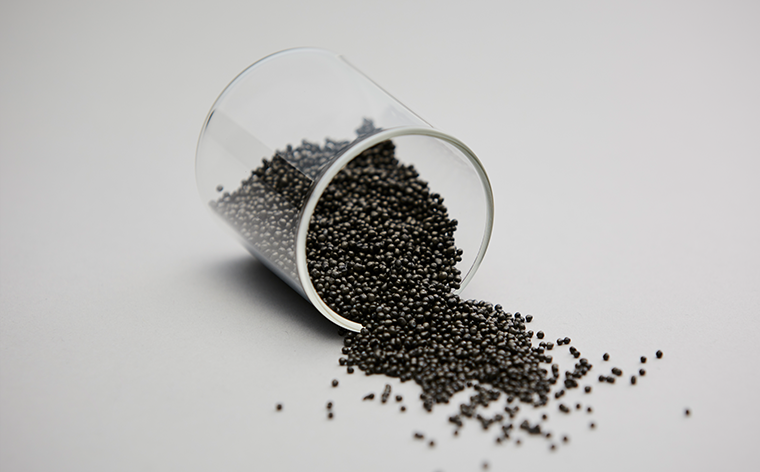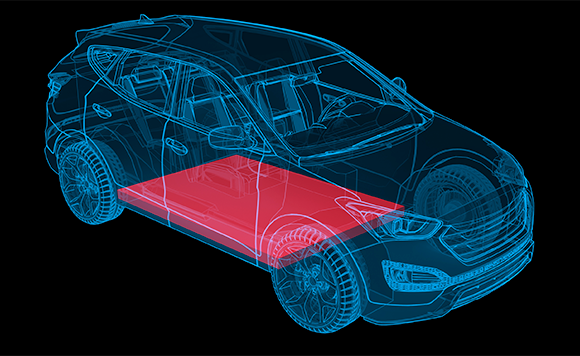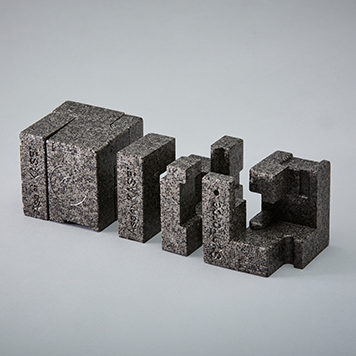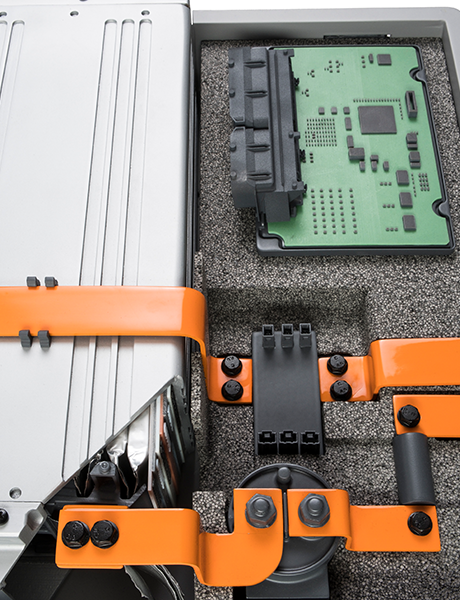m-PPE foamed beads
SunForce™
- Batteries


Marketing Areas
- ALL
While SunForce™ features properties unique to foams, such as light weight and heat insulation, it surpasses conventional foams in functions such as heat retardance, dimensional stability, and thin-wall molding.
Feature
- Flame retardance
- Heat insulation
- Dimensional stability
Usage
- LIBs
SunForce™, a foam structure that is both highly resistant to heat and highly strong, enables various parts of vehicles to be more light weight and functional.
SunForce™, a foam structure that is both highly resistant to heat and highly strong, enables various parts of vehicles to be more light weight and functional.

Flame retardance
SunForce™ has received the "V-0" rating, an extremely high-level flame retardant standard, of the UL-94 (the Standard for Safety of Flammability of Plastic Materials for Parts in Devices and Appliances testing) certified by UL (Underwriters Laboratories Limited Liability Company).
SunForce™ is the world's first foamed beads that received the V-0 rating.
Although SunForce™ is a foamed material, it is the molded material that can be used for the parts requiring heat insulation.
In addition to the UL standard, the Flammability Test for Railroad Vehicles certified SunForce™ as a "flame-retardant" material.

Heat insulation
Since SunForce™ is a foamed material, the amount of resin used for it is small. Accordingly, "conduction" through its resin parts is small. Since the independent bubbles in the material of SunForce™ keep the air inside them, "convection" caused by the flow of the air is prevented. Since the bubble diameter is very small, a large number of bubble films exist inside them, resulting in small “radiation.” By suppressing all of these three elements, SunForce™ achieves high heat insulation properties.

Dimensional stability
The dimensional change of SunForce™ is very small while it is processed. It can be formed and processed to the degree which is close to that of common injection-molded articles. SunForce™ can be safely used for structures and chassis whose dimension must be stable.
In addition, SunForce™ has the characteristics of PPE resin, which has a small linear expansion coefficient compared with that of other types of resins. Therefore, the impact of temperatures on SunForce™ is relatively minor.
In addition, to produce SunForce™, beads are filled in a metal mold, steam is used to expand the beads, and the beads are thermally bonded with each other (refer to the molding guide). Unlike the injection molding method in which resin is poured into a metal mold in a high-temperature and high-pressure environment, the thermal bonding method produces molded products with fewer warps or burrs even when the thicknesses of the molded products vary. Therefore, it can be designed freely without any shape limitation such as uniform thickness.
Reducing electricity to control battery cell temperature with the effects of heat insulation
It is known that when the temperature of a battery decreases, its output drops significantly. In certain types of electric vehicles and high-power hybrid vehicles, the battery cells are heated by a heater, etc. to prevent their temperature decrease and maintain them at an appropriate temperature.
Insulating the battery with SunForce™ can prevent the battery from losing heat during a vehicle stop. If the vehicle is stopped for several hours, a high output of the battery can be achieved without the necessity of heating by a heater. Even when a heater is used, heat loss to the outside can be minimized by the heat insulation effect of SunForce™.
SunForce™ also saves electricity for cooling the battery cells while the vehicle is running.Using SunForce™ to reduce influences of external heat increases heat exchange efficiency, maximizing battery performance.

Contribution to the environment
SunForce™ can be used as a light-weight material, heat-insulating material, or the like that contributes to the reduction of the global environmental burden.
The raw materials of SunForce™ do not contain harmful substances including halogen compounds and heavy metals. Also, SunForce™ does not contain substances subject to the RoHS Directive.
RoHS Directive:(Directive on the Restriction of the use of certain Hazardous Substances in electrical equipment)
In Europe, since July 1, 2006, the RoHS Directive has been enacted to restrict the use of hazardous substances in electrical and electronic equipment. The Directive regulates the use of six harmful substances: Lead, mercury, cadmium, hexavalent chromium, PBB, and PBDE.
The raw materials of SunForce™ also comply with other regulations including the REACH and the TSCA. Contact us for further information on conditions such as compliance with the latest REACH SVHC List.
REACH:Registration, Evaluation, Authorization and Restriction of Chemicals
The REACH Regulation is the comprehensive regulations of the European Parliament and the European Council on the registration, assessment, authorization, and restriction of chemicals, which entered into force on 1 June 2007.
TSCA:Toxic Substances Control Act
U.S. law for regulating harmful substances. Law concerning the regulation of harmful chemical substances.
More detail interview
https://asahi-kasei-mobility.com/en/interview/battery_thermal_management/
Product Q&A
QDoes SunForce™ have vibration-damping properties?
QDoes SunForce™ have antistatic properties?
If necessary, we provide a secondary process such as surface application of a surfactant after molding.
QWhat is the color of SunForce™?
QWhat types of smoke gas are emitted when SunForce™ is ignited?
QWhat are the electrical properties of SunForce™?
In addition, the material of SunForce™ contains air; therefore the dielectric constant and dielectric loss are lower than those of the raw resin.
QDoes SunForce™ have shock-absorbing properties?
QIs SunForce™ a non-flammable material?
QIs SunForce™ waterproof?
QWhy is SunForce™ flame retardant?
QIs SunForce™ hydrolyzed?
QWhat is the recyclability of SunForce™?
. It can be recycled and transformed into other materials, and thermal recycling is possible.
The method for disposing of SunForce™ is the same as that for disposing of general resins, but please dispose of it according to the instructions of the local municipality.
QCan we print something on SunForce™?
QCan it be injection molded?
QIs a higher foaming ratio possible?
QWhat is the foaming agent?
QWhat is the channel of selling SunForce™?
You need to purchase molded products from molding manufacturers or trading companies.
QAre you selling standardized products such as sheet materials, board materials, and block materials?
Contact us through the inquiry form if you need block materials which will be cut.
QCan you supply SunForce™ to countries outside Japan?
QIs SunForce™ weather-resistant?
(Long-term durability and weather resistance)
QWhat are the long-term properties of SunForce™?
(What is the degree of the thermal resistance of SunForce™?)
QWhat are the low-temperature characteristics of SunForce™?
(What is the degree of the heat resistance of SunForce™?)
QHow can we judge the details of the design criteria and appropriate shapes of SunForce™?
(Product design guide)
QDoes SunForce™ contain any substance of concern?
(Product safety)
 Mobility-related information website
Mobility-related information website

